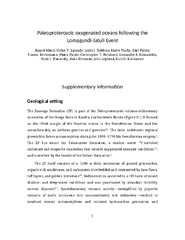Blar i forfatter "Kreitsmann, Timmu"
-
Chromium evidence for protracted oxygenation during the Paleoproterozoic
Mänd, Kaarel; Planavsky, Noah J.; Porter, Susannah M.; Robbins, Leslie J.; Wang, Changle; Kreitsmann, Timmu; Paiste, Kärt; Paiste, Päärn; Romashkin, Alexander E.; Deines, Yulia E.; Kirsimäe, Kalle; Lepland, Aivo; Konhauser, Kurt O. (Journal article; Tidsskriftartikkel; Peer reviewed, 2022-03-24)It has commonly been proposed that the development of complex life is tied to increases in atmospheric oxygenation. However, there is a conspicuous gap in time between the oxygenation of the atmosphere 2.4 billion years ago (Ga) and the first widely-accepted fossil evidence for complex eukaryotic cells . At present the gap could either represent poor sampling, poor preservation, and/or difficulties ... -
Hydrothermal dedolomitisation of carbonate rocks of the Paleoproterozoic Zaonega Formation, NW Russia — Implications for the preservation of primary C isotope signals
Kreitsmann, Timmu; Külaviir, Marian; Lepland, Aivo; Paiste, Kärt; Paiste, Päärn; Prave, Anthony R.; Sepp, Holar; Romashkin, Alexander E; Rychanchik, Dmitry V.; Kirsimäe, Kalle (Journal article; Tidsskriftartikkel; Peer reviewed, 2019-03-03)The Paleoproterozoic Zaonega Formation in Karelia, NW Russia, has played a key role in understanding the environmental conditions postdating the Great Oxidation and Lomagundi-Jatuli Events. Its carbonate- and organic-rich rocks (shungite) define the postulated Shunga Event representing an accumulation of very organic-rich sediments at c. 2 Ga and are central in ideas about changing ocean-atmosphere ... -
Identifying global vs. basinal controls on Paleoproterozoic organic carbon and sulfur isotope records
Paiste, Kärt; Lepland, Aivo; Zerkle, Aubrey L.; Kirsimae, Kalle; Kreitsmann, Timmu; Mänd, Kaarel; Romashkin, Alexander E.; Rychanchik, Dimitry V.; Prave, Anthony R (Journal article; Tidsskriftartikkel; Peer reviewed, 2020-06-03)Paleoproterozoic sedimentary successions are important archives of the redox evolution of Earth’s atmosphere and oceans. Efforts to unravel the dynamics of our planet’s early oxygenation from this archive rely on various geochemical proxies, including stable carbon and sulfur isotopes. However, ancient metasedimentary rocks often experienced early- and late-stage (bio)geochemical processes making ... -
Iron Isotopes Reveal a Benthic Iron Shuttle in the Palaeoproterozoic Zaonega Formation: Basinal Restriction, Euxinia, and the Effect on Global Palaeoredox Proxies
Mänd, Kaarel; Lalonde, Stefan V.; Paiste, Kärt; Thoby, Marie; Lumiste, Kaarel; Robbins, Leslie J.; Kreitsmann, Timmu; Romashkin, Alexander E.; Kirsimäe, Kalle; Lepland, Aivo; Konhauser, Kurt O. (Journal article; Tidsskriftartikkel; Peer reviewed, 2021-03-31)The Zaonega Formation in northwest Russia (~2.0 billion years old) is amongst the most complete successions that record the middle of the Palaeoproterozoic era. As such, geochemical data from the formation have played a central role in framing the debate over redox dynamics in the aftermath of the Great Oxidation Event (GOE). However, uncertainty over local redox conditions and the degree of ... -
Palaeoproterozoic oxygenated oceans following the Lomagundi–Jatuli Event
Mänd, Kaarel; Lalonde, Stefan V.; Robbins, Leslie J.; Thoby, Marie; Paiste, Kärt; Kreitsmann, Timmu; Paiste, Päärn; Reinhard, Christopher T.; Romashkin, Alexandr E.; Planavsky, Noah J.; Kirsimäe, Kalle; Lepland, Aivo; Konhauser, Kurt O. (Journal article; Tidsskriftartikkel; Peer reviewed, 2020-03-16)The approximately 2,220–2,060 million years old Lomagundi–Jatuli Event was the longest positive carbon isotope excursion in Earth history and is traditionally interpreted to reflect an increased organic carbon burial and a transient rise in atmospheric O<sub>2</sub>. However, it is widely held that O<sub>2</sub> levels collapsed for more than a billion years after this. Here we show that black shales ... -
A refined late-Cryogenian – Ediacaran Earth history of South China: phosphorous-rich marbles of the Dabie and Sulu orogens
Prave, Anthony R; Meng, F.; Lepland, Aivo; Kirsimäe, Kalle; Kreitsmann, Timmu; Jiang, C.Z. (Journal article; Tidsskriftartikkel; Peer reviewed, 2017-12-02)The late-Cryogenian – Ediacaran geological framework for South China is constructed principally from sedimentary successions preserved in the central and western regions of the Yangtze Block. New stratigraphic and carbonate-carbon isotope data allow us to extend that framework into the exhumed HP-UHP subduction complexes of the eastern Dabie and Sulu orogens that separate the South and North China ...


 English
English norsk
norsk




